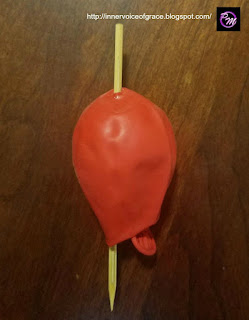Balloons have become inherent part of any party - for decoration and for kids play. What happens when a sharp object pricks a balloon? Oh, everybody knows that..the balloon goes POP! Well, you might not say that after seeing this video.
Balloons are made of polymer. Polymer is a group of molecules put together. Any chemical element is made of molecules which are basically atoms held together by chemical bonding. Chemical bonding takes place in many different ways, but am not going to enter into those details here. We can put this way, atoms hold hands together to form molecules and some molecules group together forming polymers, that's many molecules.
Coming back to the activity, when the balloon is blown the molecules get tightly packed in the center. That's where the balloon looks lighter in color. Whereas the molecules are loosely packed near the ends and its seen as darker color.
Coming back to the activity, when the balloon is blown the molecules get tightly packed in the center. That's where the balloon looks lighter in color. Whereas the molecules are loosely packed near the ends and its seen as darker color.
When a sharp object pierces the balloon somewhere in the center, the molecules don't have space to move and let the sharp object pass. So the balloon pops as the molecules try to move. But if the balloon is pierced at either ends, the molecules are able to move around a little and the object passes through without popping the balloon.
That's exactly what happens here, when I pierced the balloon with a wooden skewer. When I said am going to pierce the balloon without popping it, my kids looked at me if I was crazy. They expected the balloon the pop and they were surprised by the result. Then I showed them the distribution of molecules in a blown balloon, which can be understood by the color difference. They wanted more balloons and skewer for themselves to try.
And I had applied vaseline on the skewer which allows it to pass through the balloon more easily.
Initially, I had only smaller skewers and so I blew this red balloon small and tried. Later I got a chopstick which was bigger and I sharpened one of the ends and tried it with a white balloon, which you see in the first video above.
Ref: I saw this cool experiment in a book which I had borrowed from the local library, while arranging a Science Birthday Party for my son. The name of the book is Cool Science Tricks by Daniel Tatarsky.
Happy experimenting! Life is Science and Science is Fun!


No comments:
Post a Comment
I appreciate your valuable comments, Thanks!